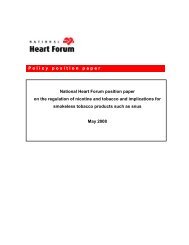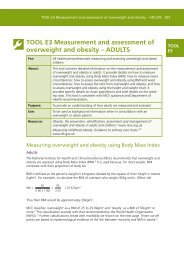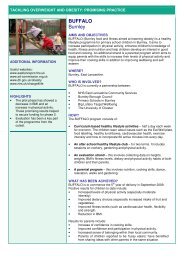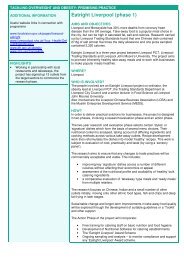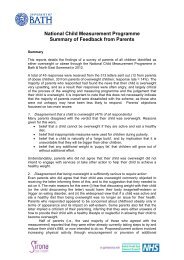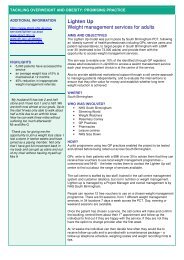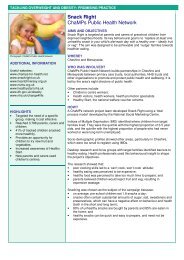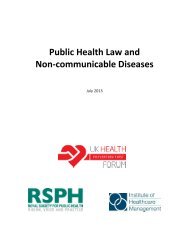The Challenge of Non-Communicable Diseases and Road Traffic ...
The Challenge of Non-Communicable Diseases and Road Traffic ...
The Challenge of Non-Communicable Diseases and Road Traffic ...
You also want an ePaper? Increase the reach of your titles
YUMPU automatically turns print PDFs into web optimized ePapers that Google loves.
56 <strong>The</strong> <strong>Challenge</strong> <strong>of</strong> <strong>Non</strong>-communicable <strong>Diseases</strong> <strong>and</strong> <strong>Road</strong> <strong>Traffic</strong> Injuries in Sub-Saharan Africa<br />
BOX 9: East African Community Medicines Regulatory Harmonization Project<br />
Strengthening governance, regulations, <strong>and</strong> accountability in the pharmaceutical sector is an important challenge <strong>of</strong><br />
health systems. Improved regulatory policies <strong>and</strong> harmonization <strong>of</strong> efforts can lead to more competitive markets, economic<br />
growth, improved access to new medicines, better quality <strong>of</strong> pharmaceuticals in circulation, <strong>and</strong> ultimately to better<br />
health outcomes.<br />
In 2009, a coalition <strong>of</strong> partners including the Pan African Parliament, NEPAD Coordinating <strong>and</strong> Planning Agency, WHO, the<br />
Bill <strong>and</strong> Melinda Gates Foundation, UK Department for International Development, <strong>and</strong> the Clinton Health Access Initiative<br />
came together to establish the African Medicines Regulatory Harmonization (AMRH) program. Working with African<br />
regional economic communities, the program’s goal is to increase access to good quality, safe, <strong>and</strong> effective medicines<br />
through harmonizing medicines regulations, <strong>and</strong> expediting the registration <strong>of</strong> essential medicines. With support from<br />
the Bill <strong>and</strong> Melinda Gates Foundation, the Global Medicines Regulatory Harmonization Multi-Donor Trust Fund (GMRH)<br />
was set up by the World Bank in 2011 to implement <strong>and</strong> scale-up AMRH activities. In 2012, the East African Community<br />
(EAC) became the first regional economic community in Africa to receive GMRH funding.<br />
<strong>The</strong> East African Community Medicines Regulatory Harmonization Project (US$5.5 million grant) is a five-year project that<br />
will be implemented in two phases. GMRH provides support for Phase I which covers the first three years (2012-2015) <strong>of</strong><br />
the project. <strong>The</strong> project’s aims are: to harmonize medicine registration systems, to improve efficiency, <strong>and</strong> to enhance<br />
transparency in medicines registration among EAC Partner States (Burundi, Kenya, Rw<strong>and</strong>a, Tanzania, <strong>and</strong> Ug<strong>and</strong>a). <strong>The</strong><br />
results <strong>of</strong> this innovative partnership are expected to include: (1) EAC Partner States participating in harmonized medicine<br />
registration; (2) National Medicine Regulatory Authorities (NMRAs) using common integrated Information Management<br />
System; (2) NMRAs have a functioning quality management system in place; (4) regulatory capacity building in the region<br />
institutionalized; <strong>and</strong> (5) government, industry, <strong>and</strong> civil society partnerships improved. As the project moves ahead, continuous<br />
dialogue <strong>and</strong> collaboration with local industry <strong>and</strong> civil society groups will be emphasized to improve the quality<br />
<strong>of</strong> technical st<strong>and</strong>ards being developed.<br />
Source: [395]<br />
made the situation worse, where vertical approaches<br />
to planning <strong>and</strong> managing health systems crowded<br />
out pre-existing, more-integrated approaches <strong>and</strong><br />
attention to NCDs.<br />
Health-care infrastructure is insufficient across all<br />
tiers <strong>of</strong> service delivery, not just in the case <strong>of</strong> facilities<br />
but also laboratory <strong>and</strong> diagnostic systems <strong>and</strong><br />
capabilities. <strong>The</strong> WHO African Region as a whole<br />
had the lowest ratio <strong>of</strong> hospital beds per 10,000 <strong>of</strong><br />
population <strong>of</strong> any region, which ranged from one<br />
in Mali to 63 in Gabon (global average 30) [397].<br />
Chronic NCDs may be over-represented in hospitals,<br />
with patients lingering for weeks or months,<br />
partly because <strong>of</strong> a lack <strong>of</strong> reliable outpatient facilities<br />
for follow up; one study in Rw<strong>and</strong>a found that<br />
these conditions accounted for 30-40 percent <strong>of</strong><br />
adult hospitalization time [56].<br />
<strong>The</strong>re is a growing sector <strong>of</strong> private health care<br />
providers in some parts <strong>of</strong> Africa which already<br />
treats a significant proportion <strong>of</strong> those covered by<br />
private health care insurance <strong>and</strong> the well-to-do<br />
[398].<br />
<strong>The</strong> use <strong>of</strong> traditional medicine is widespread,<br />
<strong>of</strong>ten in parallel to modern medicine: in some SSA<br />
countries, 80 percent <strong>of</strong> the population rely on traditional<br />
medicine for primary health care [399].<br />
Payment is always out-<strong>of</strong>-pocket <strong>and</strong> can be substantial:<br />
a national survey in South Africa in 2008<br />
found that there was widespread use <strong>and</strong> that almost<br />
three-quarters <strong>of</strong> the poorest quintile had spent<br />
more than 10 percent <strong>of</strong> their household expenditure<br />
in the previous month on traditional healers<br />
[400-401].<br />
Primary health care in much <strong>of</strong> SSA is dismal,<br />
<strong>and</strong> prevention <strong>and</strong> promotion aspects are limited.<br />
A study in Senegal <strong>and</strong> Tanzania found that on average<br />
only 19 percent <strong>of</strong> primary health facilities in<br />
Tanzania <strong>and</strong> 39 percent in Senegal had access to<br />
basic infrastructure (electricity, water, sanitation)<br />
[358]. Around half (47 percent) <strong>of</strong> clinics in Senegal<br />
<strong>and</strong> one-fifth (22 percent) in Tanzania did not have<br />
access to the most basic equipment (thermometer,<br />
stethoscope, weighing scale) <strong>and</strong> around one-fifth<br />
<strong>of</strong> clinics (22 percent Senegal; 24 percent Tanzania)



